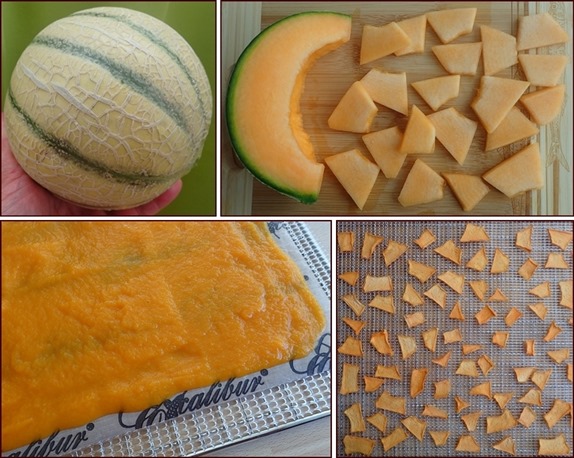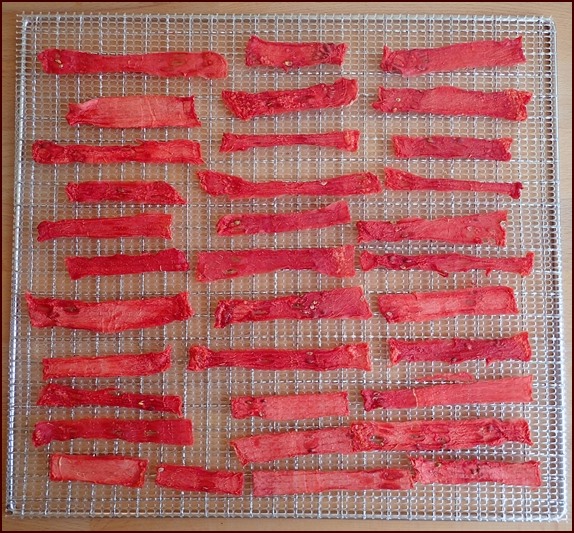Dehydrating Cantaloupe & Cantaloupe Fruit Leather
Dehydrating cantaloupe is a great way to nourish your hard-hiking self with a heaping helping of vitamins A and C, plus a healthy assortment of B vitamins, minerals, and antioxidants. At 90% water, a whole cantaloupe will weigh only 2 ounces after you dry it. See Cantaloupe Nutrition Facts.
Dehydrated cantaloupe is pleasantly sweet, but not as sweet as dehydrated watermelon. It is not sticky like dried watermelon can be. Cantaloupe lovers will appreciate the concentrated cantaloupe flavors in dried cantaloupe.
This article shows how to dehydrate cantaloupe in pieces or jerky shapes, plus how to make cantaloupe fruit leather in combination with other fruits and vegetables.
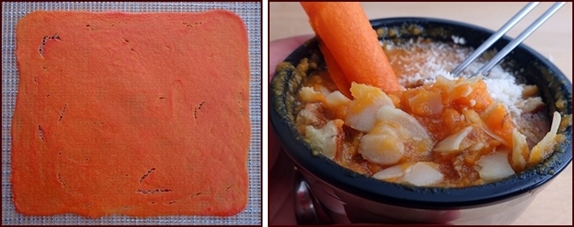
Photos: Dehydrated Cantaloupe & Carrot Fruit Leather with Ginger on left, rehydrated with cold water in 5 minutes into a healthy pudding with added nuts and coconut.
Or try the Pear-Cantaloupe Fruit Leather with Mint recipe that also rehydrates with cold water in 5 minutes. Now you have a good reason to take a pudding pause at that next stream crossing.
Table of Contents
How to Choose a Ripe Cantaloupe
Choosing a perfectly ripe cantaloupe is key for dehydrating cantaloupe that tastes good. Underripe cantaloupes lack sweetness and flavor, and overripe cantaloupes taste like fermentation has already commenced. Overripe cantaloupes may also have a mushy texture inside, especially around the seed cavity.
Cantaloupes do not ripen further after they are picked, so choose wisely at the store.
- Color should be golden-tan, not light green, although some varieties of cantaloupe will retain their green, umbrella-like channels.
- The cantaloupe should feel heavy and solid without a lot of give when you squeeze it lightly.
- Smell the flower end which is opposite the stem end. You should detect a pleasant, sweet odor.
- Look for a slight indentation at the stem end. If there is no stem attached, the cantaloupe was probably picked at peak-ripeness.
More often than not, the stems on the cantaloupes in the bin may all have stems still attached, so look for that indentation on the stem end, and a pleasant odor at the other end.
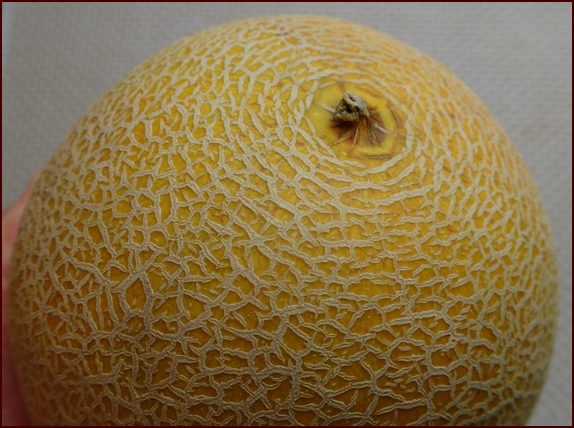
Photo: A Galia cantaloupe. Notice the slight indentation under the stem which is a hint that the cantaloupe is ripe.
Cantaloupes, while they will not ripen further after you bring them home, they will begin to ferment after a few days. They’re a magnet for fruit flies. Dehydrating cantaloupe within 2–3 days after purchase is the best practice.
You may be surprised, when cutting into a cantaloupe, that the flesh is light green instead of orange. That produce manager slipped a Galia cantaloupe into the bin, which is a cross between a cantaloupe and a honeydew melon. Galia cantaloupes are even sweeter than the orange varieties. To dehydrate honeydew melon, follow the instructions for dehydrating cantaloupe.
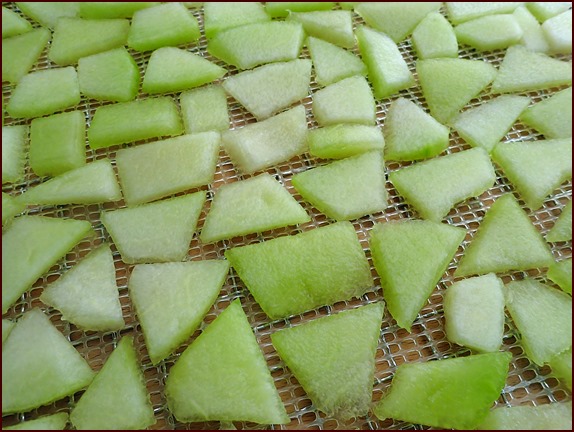
Photo: Galia cantaloupe cut into pieces on mesh sheet of dehydrator tray.
Dehydrating Cantaloupe
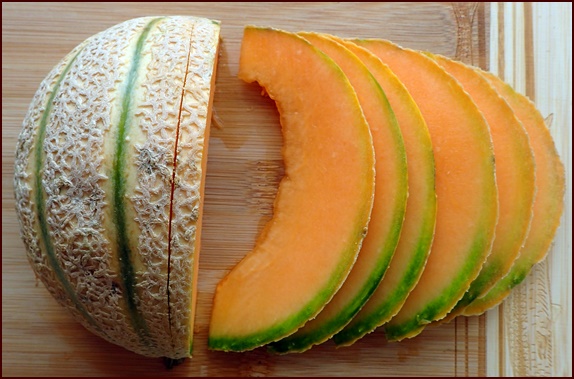
Preparation
Wash and dry cantaloupe before cutting into it.
Cut cantaloupe in half longwise, remove seeds, and then cut each half into ¼-inch thick slices.
Trim away the rind and cut flesh into pieces or crescent-moon shapes.
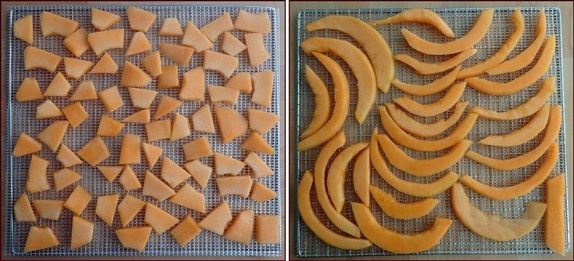
You can fit more cantaloupe on a dehydrator tray if you cut the ¼-slices into pieces, but it’s still fun to snack on dehydrated cantaloupe that resembles the shape of an actual cantaloupe slice.
Dehydrate cantaloupe at 135°F (57°C) for approximately 8–10 hours until no moisture is present when you tear a piece in half. Dried cantaloupe will be pliable.
Yield: Half a cantaloupe weighing 250 grams after cutting will weigh approximately 28 grams when dry with a volume of ¾-cup.
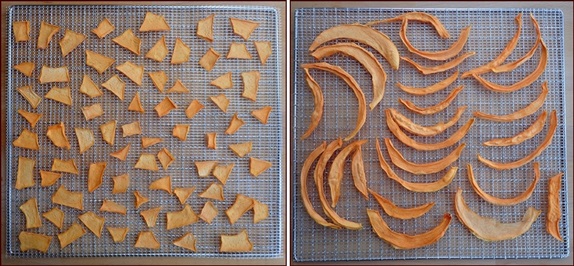
Observation: When dehydrating cantaloupe, air pockets may form here and there, as shown in the photo below. Before you store the dried cantaloupe, poke a few of these air pockets with the tip of a knife to make sure there is no hidden moisture.
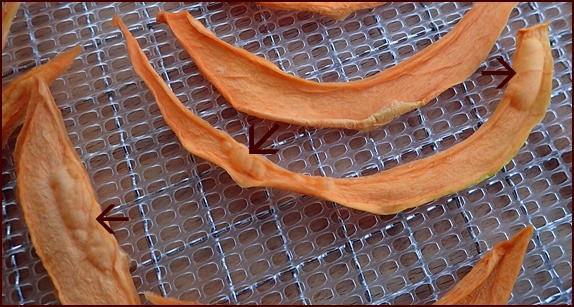
Photo: Air pockets in dehydrated cantaloupe.
Storing Dehydrated Cantaloupe
For long shelf life of up to a year, store dehydrated cantaloupe in an airtight container. It’s fine to use a sealed Ziploc bag for short term storage and transport. If left out in the open too long, dried cantaloupe will absorb moisture from the environment, which could lead to mold growth.
Rehydrating Dehydrated Cantaloupe
Dried cantaloupe is best for snacking on, “as is.” It does not rehydrate well, and the texture feels a little slippery in your mouth. However, cantaloupe fruit leather can be rehydrated into a healthy pudding or smoothie in 5 minutes.
Cantaloupe Fruit Leather Recipes
Since cantaloupe is 90% water, it makes a better fruit leather when combined with another fruit or vegetable with a lower water content. The first recipe includes pears, and the second recipe includes carrots.
Cantaloupe-Pear Fruit Leather with Mint
The mint in this fruit leather makes it very refreshing.
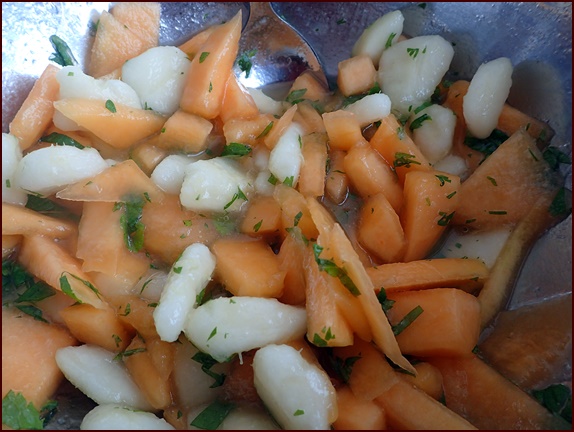
Servings: Make 2 fruit leathers, 1 cup each
Ingredients:
- 250 g cantaloupe pieces
- 250 g pear pieces
- 2 Tbsp. fresh chopped mint leaves
- 1 Tbsp. fresh lime juice (¼–½ lime)
- 1 tsp. honey
Instructions:
Run ingredients through a blender until smooth.
Spread thinly on dehydrator trays covered with nonstick sheets. This recipe produces approx. 2 cups, so plan for 1 cup per tray.
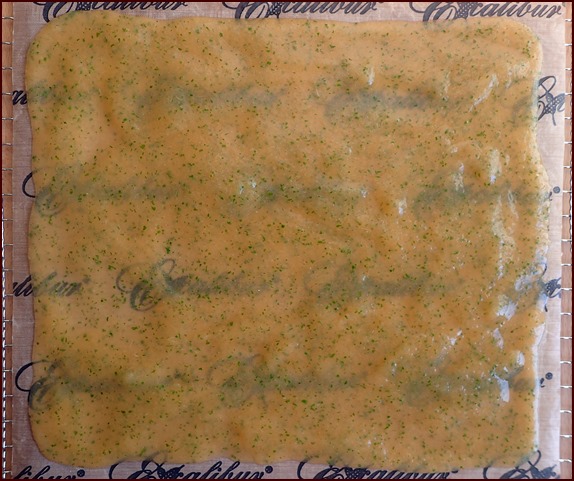
Dehydrate cantaloupe fruit leather at 135°F (57°C) for approximately 9–11 hours.
When the leather is almost finished drying, flip it over onto a mesh sheet and peel off the nonstick sheet. This will ensure complete drying.
Dried fruit leather will be pliable and slightly tacky. If you leave it out in the open, it will absorb moisture from the air quickly and get sticky.
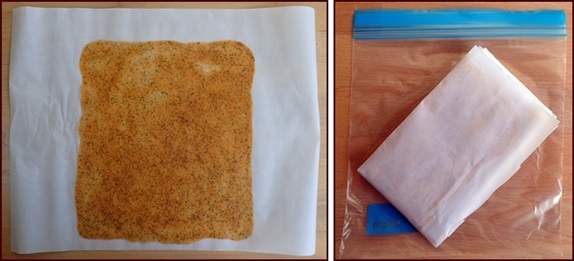
To keep dehydrated cantaloupe fruit leather from sticking to itself in storage or transport, fold it up in parchment paper and pack in Ziploc bags. Several folded leathers will fit in 1 bag.
Dehydrated cantaloupe fruit leather stores well. It’s best to use it within a few months, but if stored in an airtight container, it can last up to a year.
Cantaloupe-Pear Fruit Leather with Mint Pudding
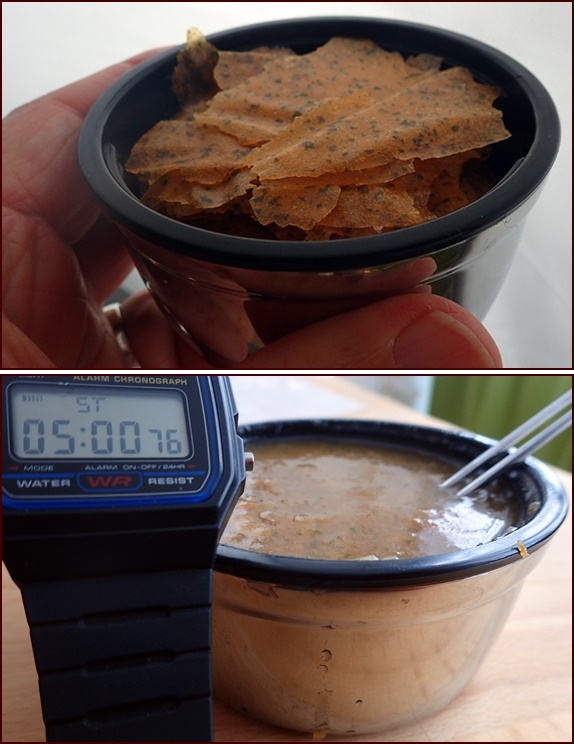
Photo: Fruit leather rehydrated with cold water… your pudding is ready in 5 minutes!
On the Trail:
Tear 1 sheet of fruit leather, (30–35 g), into pieces and place in a cup such as the thermos food jar cap shown in the photo above.
Cover with cold water and stir until fruit leather is dissolved, about 5 minutes.
Carrot-Cantaloupe Fruit Leather with Ginger
This fruit leather flavor is high in vitamins A and C. The ginger gives it a nice zing.
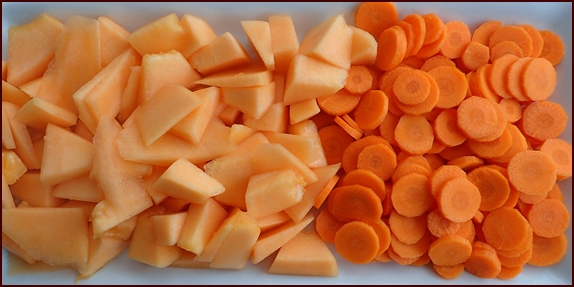
Servings: Makes 2 fruit leathers 1 cup each.
Ingredients:
- 350 g cantaloupe pieces, about ½ a cantaloupe
- 150 g steamed carrots, 1 cup
- 3 Tbsp. orange juice
- 1 tsp. fresh-grated ginger root
- 1 tsp. honey
Instructions:
Peel and slice carrots thinly. Steam for 10 minutes, drain, and let cool. Steaming the carrots makes them blend better with the cantaloupe. It also makes the beta-carotene present in the carrots more bioavailable as vitamin A during digestion.
Peel and finely grate about 1 inch of fresh ginger root.
Combine the steamed carrots with the other ingredients in a blender and blend until smooth.
Spread thinly on dehydrator trays covered with nonstick sheets. This recipe produces approx. 2 cups, so plan for 1 cup per tray.
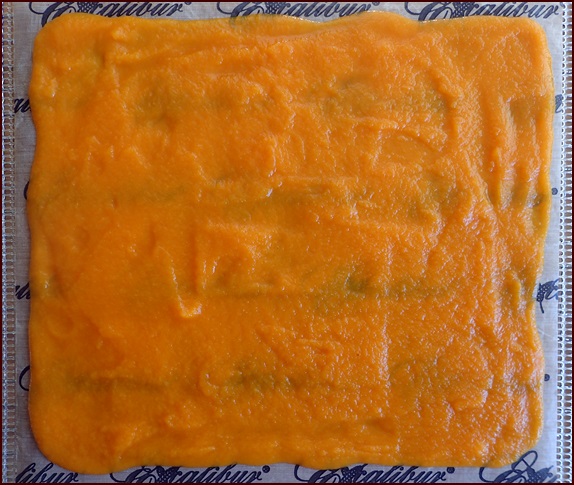
Dehydrate at 135°F (57°C) for approximately 7–9 hours. Dried fruit leather will be pliable and slightly tacky. Some cracks may form in the fruit leather due to the presence of the carrots.
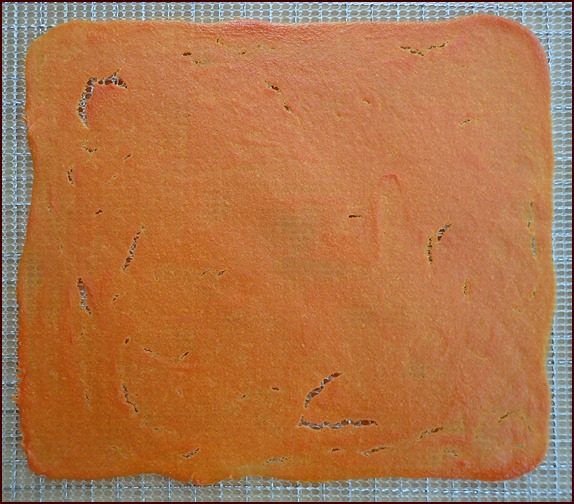
When the leather is almost dry, flip it over onto a mesh sheet and peel off the nonstick sheet. This will ensure complete drying.
As soon as the leather dries, fold it up in parchment paper and store it in a Ziploc bag or airtight container.
Carrot-Cantaloupe Fruit Leather Pudding
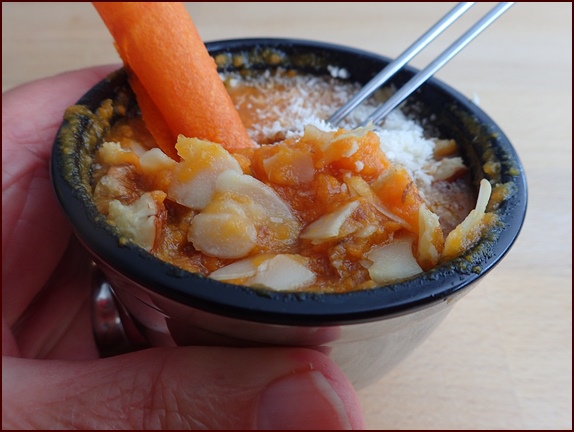
On the Trail:
Tear 1 sheet of fruit leather, (30–35 g), into pieces and place in a cup such as the thermos food jar cap shown in the photo above.
Cover with cold water and stir until fruit leather is dissolved, about 5 minutes.
Stir in extras like almond slices and shredded coconut. Delicious!
Explore More…
Food Drying & Trail Cooking Gear Guide
Products to help you with your food drying projects and trail cooking adventures. I use the featured products regularly, or they are recommended by Backpacking Chef readers.
Share this page with friends on social media.
Free E-book & Newsletter
Free with Trail Bytes subscription.
Dehydrating Food from A–Z

